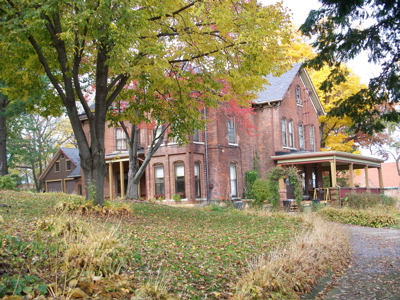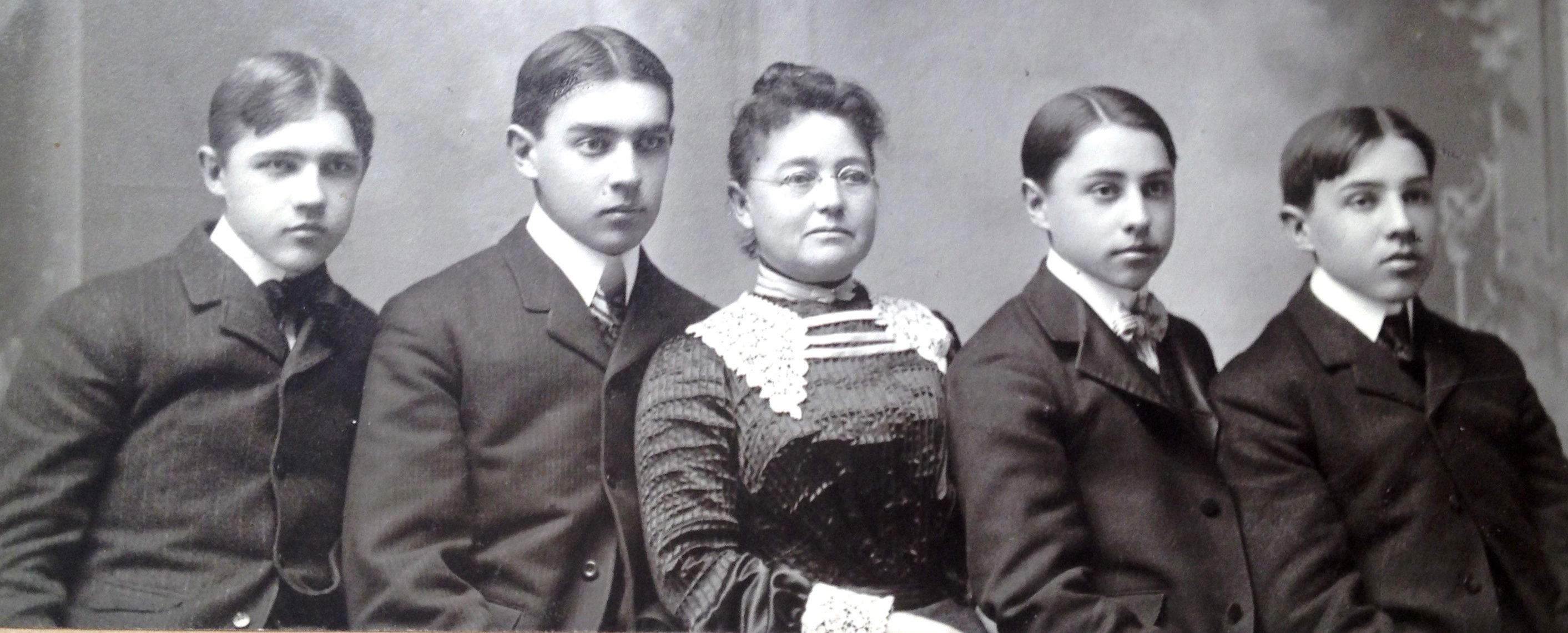Encyclopedia Dubuque
"Encyclopedia Dubuque is the online authority for all things Dubuque, written by the people who know the city best.”
Marshall Cohen—researcher and producer, CNN
Affiliated with the Local History Network of the State Historical Society of Iowa, and the Iowa Museum Association.
WALLIS, John Rider (Home)
WALLIS, John Rider (Home)
The History of 1295 Prairie St. (Originally 121 Prairie)
By John Rider Wallis, 1977
At last there is a fine family in our old home. We had a good visit with the new owners, Mr. and Mrs. Welsh, some months ago. It seemed good to find a family using every room and working hard to improve the property. Mrs. Welsh is a graduate nurse and was on duty at Xavier Hospital when I was recovering from my heart flare up. I took her the album with a set of pictures of every room taken in 1917, when I was living alone, (Mother died in December, 1916). The Welsh family enjoyed seeing each view and hearing the history of the place.
When I examined each picture I made note of the conveniences afforded fifty or sixty years ago. I might be interesting to record things we did not have at 121 Prairie St. and tell of the changes through the years.
First of all, as far back as I can remember we did have a bathroom, but, of course, a three hole convenience was provided in the back yard. I can remember telling a classmate perhaps in the sixth class, that we had two bathrooms. I think I was rather proud of the fact as my friend, also of a wealthy lumber family, admitted they only had one bathroom. Our second (new) bathroom came about when the dining room was extended and one bedroom and bathroom added. This must have been in about 1898. The bedroom became known as the “boy’s bedroom.”
There were four sons of John William WALLIS and Mary Burton Wallis--William Burton Wallis, James Harold WALLIS, Joseph Allen Wallis, and John Rider Wallis. All the sons were called by their middle name--just as their father was.
We didn’t have: Electric lights until about 1900 when by taking advantage of a cut rate, six room offer, a very simple wiring job was performed and drop cords with electric lamps hung among the gas chandeliers. There were brackets holding kerosene lamps in the kitchen and upstairs hall. These show in the 1917 photographs. I have filled kerosene lamps and cleaned lamp chimneys at home and, of course, this was routine procedure at Derby Grange - (The best way to clean the black smudge from inside a lamp chimney is crumple up a piece of newspaper and force in and out several times). Derby Grane was a lovely summer home that became quite the gathering place for the Wallis's. In later years after the families moved away, the Mulgrew family bought the place and raised the actress Kate MULGREW there.
We had no telephone until about 1898 when a few installations were made in the hill district. Our number was 252 and Aunty Winall had 282. The house was closed May 14, 1917 and the phone disconnected for the duration. When I returned from the war and asked for service the manager mentioned some number - not 252. It was then, and only then, I made a plea as a returned soldier serving our country and was granted the old familiar #252, which was retained until a new numbering system was adopted for the entire city about 1947.
The record of telephone communication for 121 Prairie St. would not be complete without mentioning the unique device installed by my father in 1881 at the time Grandfather had the library and large bedroom added - (the property was a wedding present from James Wallis to his only son John William and Mary Burton Wallis, Nov. 23, 1881). A wire was stretched from Grandfather’s bedroom (now the Winall House), to Mother’s bedroom. At each end of the wire a strange box was concave front and a round button provided a one-way conversation. By tapping on the metal button a clicking noise would call someone to the so -called phone and a back and forth conversation could be carried on. The contraption was still in place in my childhood and I can remember tapping and hoping for an answer. For a widow with four babies the assurance of contact with Grandfather was comforting. The bedroom door was bolted each night when all four were safe in bed.
We did not have steam heat or hot water with thermostatic controls as now enjoyed by the Welsh folks. A very large bricked in cast iron furnace was the modern innovation of the 1880’s. Like the fiery furnace of Nebuchadnezzar the old furnace was never satisfied. To feed this demon cord wood (four foot sticks) was cut in the timber beyond Derby Grange or Durango and brought on sleighs or by wagon. In the fall and winter cord upon cord was piled in the side yard near the parlor windows. When old enough it was part of the household duties, and a very important part, for all four Wallis boys to pitch in to help unload and pile the wood. No matter what the weather the next job called for brawn and some skill to throw the heavy cord wood down a chute through a cellar window. The next operation required piling the wood ceiling height in the room under the parlor and a cord or more by the furnace. This little duty continued through my boyhood, young manhood and into the early years of married life.
What a day - What a day, when Mr. Spellerberg put in the “modern” round furnace made to burn soft coal or chunks of wood. Years passed and an oil burner made a brave effort to bring a measure of comfort to the living rooms - with little success in the bedrooms. My boys will remember the next try at modernizing a hot air system, the installation of an iron fireman stoker. John was the last of the boys to struggle with feeding this new demon. I shall always remember and see him of a Saturday carrying bushel after bushel of clinkers from the weekly accumulation, up the stairs through the kitchen, where Dorothy, Rider's wife, placed newspapers on the floor, then to the end of the driveway on Walnut Street. This should be told - regarding inadequate heating in the old homestead. Grandma Wilson came to live with us after her daughter, Aunt Grace, married and the Main Street house was vacated.
Grandma Wilson was Rider's grandmother on his mother's side of the family. Originally Mary Barton she married William Gell in England. He died of tuberculosis. She then married John Burton and came to the United States. They had a daughter, Mary Burton. After John Burton died, she married General M.S. Stokely and finally married Judge Thomas S. WILSON.
As has been suggested it was not always easy to combat a north wind and keep Grandma’s little bedroom comfortable. When we would make excuses for the old furnace our then past eighty grandmother would say quite emphatically, “There’s nothing the matter with the furnace, just keep putting in the wood”.
When looking through the old photo book note a gas fixture in the side hall, usable, the old style telephone on a little shelf. There were two gas fixtures. In the side hall, usable, the old style telephone on a little shelf. There were two gas fixtures near the bay window in the dining room. The kitchen was really an 1890 Museum, a combination coal-wood stove, called Copper Clad. I remember when it was purchased, reduced from $70.00 to $60.00. A tank in the rear of the stove to create hot water - a large copper water tank stood behind the stove with pipes connected with the stove. The copper clad job did noble service in the kitchen at Cloie Fork Farm, near Durango until an electric stove took over.
No kitchen was complete without a big wood box, and many an arm full of split wood I’ve carried from back shed to fill the wood box. Two large cisterns provided soft water for the kitchen. A pitcher pump was in a convenient place near the sink, but the almost daily task was pumping from the cistern to a large tank in the attic. The Wallis boys took turns at the basement pump a hundred or five hundred strokes, whatever was necessary to fill the tank, and what a joyful sound when the overflow gauge permitted water to fun down the “telltale” - showing the tank could take no more.
If you could follow me through each room you would find a bell pull on the wall in the library, another in the hall and for any emergency one on the wall by the bathtub in the old bathroom. By pulling the handle a bell would ring in the kitchen. While in High School I installed a box on the kitchen wall with arrows to point to indicate which bell had been pressed - front door, side door or dining room. The speaking tube in the “nursery”, connected with an opening in the kitchen, affording much fun making the whistle blow in the kitchen or bedroom.
And don’t forget the only heat for the back bathroom came from a stove pipe fun through the kitchen ceiling. Talk about a Spartan experience - taking a bath of a cold winter Saturday night. In Sally’s, his daughter, childhood an electric heater was used to warm the room and her life was saved by quick action by recovering the heater about to fall into the tub of water. So much for the home of my childhood and the things that were unchanged when I came back from two years of war.
Information provided by Kristen Gorton
Additional information in italics and pictures were offered by Andrea Wallis Aven.




